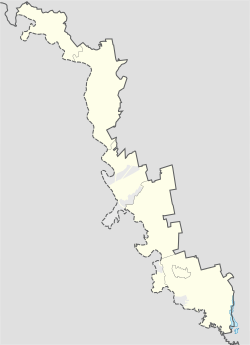Chițcani (Dniester)
| Кицкань ( rum. ) | ||
|
Кицканы ( Russian ) |
||
| Кіцкани ( ukr. ) | ||
| State : |
|
|
| Rajon : | Slobodseja / Căușeni | |
| Founded : | 1367 | |
| Coordinates : | 46 ° 47 ' N , 29 ° 37' E | |
| Height : | 4 m. ü. M. | |
| Residents : | 9,500 (2010) | |
| Time zone : | Eastern European Time | |
| Telephone code : | (+373) 210 | |
|
|
||
Chițcani ( Russian Кицканы Kizkany , Ukrainian Кіцкани Kizkany ) is a place in Transnistria or the Republic of Moldova . The village, founded in 1367, is one of the oldest settlements in the region and is located on the west bank of the Dniester , opposite Tiraspol . Chițcani is known for its Noul Neamț monastery, founded in 1861 .
Chițcani has been controversial since the Transnistria conflict in 1992 between Transnistria and the Republic of Moldova . It is one of the few settlements west of the Dniester that is controlled by Transnistria. From the Moldovan point of view, the village is part of the Căușeni district , and from the Transnistrian point of view it belongs to the Slobodseja district .
history
The year 1367 is given as the date of foundation, but there are indications that the village may have existed earlier. Alexandru cel Bun donated a piece of land to the Orthodox Church in 1429, which established a monastery here, which became an important religious center. The donation of land was confirmed by Ștefan cel Mare in 1463 and 1500 and increased by further land, as well as by the following voivodes (regional princes ) Petru Rareș in 1546 and Aron Tiranul in 1581.
Prince Alexandru Ioan Cuza , founder of the Principality of Romania in 1859, expropriated the Moldovan monasteries west of the Prut , which is why many monks moved east into the Russian sphere of influence . The Mănăstirea Noul Neamț (Romanian, "Neu-Niamtz Monastery", Russian Кицканский монастырь) was founded in 1861 by monks from the Neamț Monastery in Romania and was recognized as a monastery in 1864 at a synod in Saint Petersburg . The buildings were built between 1865 and 1905. They include the main church, two other churches, a bell tower , residential and auxiliary buildings. The 68 meter high bell tower with its five floors is the highest in the country.
The settlement went through a strong development after Bessarabia became part of the Russian Empire in 1812 . After the First World War, Bessarabia fell to Romania, in 1940 to the Soviet Union, then briefly reoccupied by Romania and finally ceded to the Soviet Union in 1945. Chițcani was then part of the Moldovan SSR . The monastery was closed in 1962 under Soviet rule. The former monastery buildings were used as a hospital and partly as a museum. The gradual revival as a monastery began in the late 1980s. In 1989 one of the church buildings on the site was used again as a church for the first time. In 1991 the Soviet Union dissolved and the Moldovan SSR declared its independence. Subsequently, the Transnistrian conflict arose. Since 1992 Chițcani has belonged to the de facto independent Transnistria and is not under the control of Moldova. Around 1999/2000 monastery life was reactivated and monks moved to the area.
In Chițcani there was an above-average proportion of Russian-speaking population as early as the 19th century, but this fell again from 1918 after the annexation to Romania. At the 1930 census, 51.2% of the population said Romanian was their mother tongue and 47.3% said Russian. In 2004, 53% of the population were ethnic Russians, 34% Moldovans and 10% Ukrainians. There were also smaller minorities of Bulgarians , Gagauz and Belarusians .
literature
- Chițcani Monastery. In: Andrei Brezianu: Historical Dictionary of the Republic of Moldova (= European History Dictionaries. No. 37). The Scarecrow Press, Lanham (Maryland) / London 2007, p. 82 f.
Web links
- Website of the monastery (Russian)
- The Monastery of Holy Ascension of the Lord in New Neamt, near Bendery, Moldova. Orthodox Moldova
Individual evidence
- ↑ Sabin Manuilă: Recensământul general al populatiei României din 29 decemvrie 1930 . Ed .: Institutul Central de Statistică. tape 2 : Neam, Limbă Maternă, Religie . Bucharest 1938, p. 462 ( Textarchiv - Internet Archive ).

